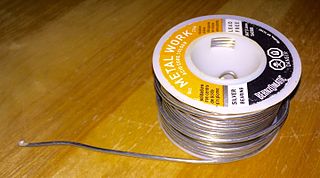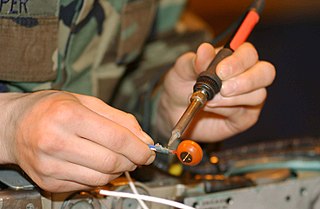| element | role | volatility | corrosion resistance | cost | incompatibility | description |
|---|
| Silver | structural, wetting | volatile | | expensive | | Enhances capillary flow, improves corrosion resistance of less-noble alloys, worsens corrosion resistance of gold and palladium. Relatively expensive. High vapor pressure, problematic in vacuum brazing. Wets copper. Does not wet nickel and iron. Reduces melting point of many alloys, including gold-copper. |
|---|
| Copper | structural | | | | ammonia | Good mechanical properties. Often used with silver. Dissolves and wets nickel. Somewhat dissolves and wets iron. Copper-rich alloys sensitive to stress cracking in presence of ammonia. |
|---|
| Zinc | structural, melting, wetting | volatile | low | cheap | Ni | Lowers melting point. Often used with copper. Susceptible to corrosion. Improves wetting on ferrous metals and on nickel alloys. Compatible with aluminum. High vapor tension, produces somewhat toxic fumes, requires ventilation; highly volatile above 500 °C. At high temperatures may boil and create voids. Prone to selective leaching in some environments, which may cause joint failure. Traces of bismuth and beryllium together with tin or zinc in aluminum-based braze destabilize oxide film on aluminum, facilitating its wetting. High affinity to oxygen, promotes wetting of copper in air by reduction of the cuprous oxide surface film. Less such benefit in furnace brazing with controlled atmosphere. Embrittles nickel. High levels of zinc may result in a brittle alloy. [18] Prone to interfacial corrosion in contact with stainless steel in wet and humid environments. Unsuitable for furnace brazing due to volatility. |
|---|
| Aluminum | structural, active | | | | Fe | Usual base for brazing aluminum and its alloys. Embrittles ferrous alloys. |
|---|
| Gold | structural, wetting | | excellent | very expensive | | Excellent corrosion resistance. Very expensive. Wets most metals. |
|---|
| Palladium | structural | | excellent | very expensive | | Excellent corrosion resistance, though less than gold. Higher mechanical strength than gold. Good high-temperature strength. Very expensive, though less than gold. Makes the joint less prone to fail due to intergranular penetration when brazing alloys of nickel, molybdenum, or tungsten. [19] Increases high-temperature strength of gold-based alloys. [17] Improves high-temperature strength and corrosion resistance of gold-copper alloys. Forms solid solutions with most engineering metals, does not form brittle intermetallics. High oxidation resistance at high temperatures, especially Pd-Ni alloys. |
|---|
| Cadmium | structural, wetting, melting | volatile | | | toxic | Lowers melting point, improves fluidity. Toxic. Produces toxic fumes, requires ventilation. High affinity to oxygen, promotes wetting of copper in air by reduction of the cuprous oxide surface film. Less such benefit in furnace brazing with controlled atmosphere. Allows reducing silver content of Ag-Cu-Zn alloys. Replaced by tin in more modern alloys. In EU since December 2011 allowed only for aerospace and military use. [20] |
|---|
| Lead | structural, melting | | | | | Lowers melting point. Toxic. Produces toxic fumes, requires ventilation. |
|---|
| Tin | structural, melting, wetting | | | | | Lowers melting point, improves fluidity. Broadens melting range. Can be used with copper, with which it forms bronze. Improves wetting of many difficult-to-wet metals, e.g. stainless steels and tungsten carbide. Traces of bismuth and beryllium together with tin or zinc in aluminum-based braze destabilize oxide film on aluminum, facilitating its wetting. Low solubility in zinc, which limits its content in zinc-bearing alloys. [18] |
|---|
| Bismuth | trace additive | | | | | Lowers melting point. May disrupt surface oxides. Traces of bismuth and beryllium together with tin or zinc in aluminum-based braze destabilize oxide film on aluminum, facilitating its wetting. [18] |
|---|
| Beryllium | trace additive | | | | toxic | Traces of bismuth and beryllium together with tin or zinc in aluminum-based braze destabilize oxide film on aluminum, facilitating its wetting. [18] |
|---|
| Nickel | structural, wetting | | high | | Zn, S | Strong, corrosion-resistant. Impedes flow of the melt. Addition to gold-copper alloys improves ductility and resistance to creep at high temperatures. [17] Addition to silver allows wetting of silver-tungsten alloys and improves bond strength. Improves wetting of copper-based brazes. Improves ductility of gold-copper brazes. Improves mechanical properties and corrosion resistance of silver-copper-zinc brazes. Nickel content offsets brittleness induced by diffusion of aluminum when brazing aluminum-containing alloys, e.g. aluminum bronzes. In some alloys increases mechanical properties and corrosion resistance, by a combination of solid solution strengthening, grain refinement, and segregation on fillet surface and in grain boundaries, where it forms a corrosion-resistant layer. Extensive intersolubility with iron, chromium, manganese, and others; can severely erode such alloys. Embrittled by zinc, many other low melting point metals, and sulfur. [18] |
|---|
| Chromium | structural | | high | | | Corrosion-resistant. Increases high-temperature corrosion resistance and strength of gold-based alloys. Added to copper and nickel to increase corrosion resistance of them and their alloys. [17] Wets oxides, carbides, and graphite; frequently a major alloy component for high-temperature brazing of such materials. Impairs wetting by gold-nickel alloys, which can be compensated for by addition of boron. [18] |
|---|
| Manganese | structural | volatile | good | cheap | | High vapor pressure, unsuitable for vacuum brazing. In gold-based alloys increases ductility. Increases corrosion resistance of copper and nickel alloys. [17] Improves high-temperature strength and corrosion resistance of gold-copper alloys. Higher manganese content may aggravate tendency to liquation. Manganese in some alloys may tend to cause porosity in fillets. Tends to react with graphite molds and jigs. Oxidizes easily, requires flux. Lowers melting point of high-copper brazes. Improves mechanical properties and corrosion resistance of silver-copper-zinc brazes. Cheap, even less expensive than zinc. Part of the Cu-Zn-Mn system is brittle, some ratios can not be used. [18] In some alloys increases mechanical properties and corrosion resistance, by a combination of solid solution strengthening, grain refinement, and segregation on fillet surface and in grain boundaries, where it forms a corrosion-resistant layer. Facilitates wetting of cast iron due to its ability to dissolve carbon. Improves conditions for brazing of carbides. |
|---|
| Molybdenum | structural | | good | | | Increases high-temperature corrosion and strength of gold-based alloys. [17] Increases ductility of gold-based alloys, promotes their wetting of refractory materials, namely carbides and graphite. When present in alloys being joined, may destabilize the surface oxide layer (by oxidizing and then volatilizing) and facilitate wetting. |
|---|
| Cobalt | structural | | good | | | Good high-temperature properties and corrosion resistance. In nuclear applications can absorb neutrons and build up cobalt-60, a potent gamma radiation emitter. |
|---|
| Magnesium | volatile O2 getter | volatile | | | | Addition to aluminum makes the alloy suitable for vacuum brazing. Volatile, though less than zinc. Vaporization promotes wetting by removing oxides from the surface, vapors act as getter for oxygen in the furnace atmosphere. |
|---|
| Indium | melting, wetting | | | expensive | | Lowers melting point. Improves wetting of ferrous alloys by copper-silver alloys. Suitable for joining parts that will be later coated by titanium nitride. [20] |
|---|
| Carbon | melting | | | | | Lowers melting point. Can form carbides. Can diffuse to the base metal, resulting in higher remelt temperature, potentially allowing step-brazing with the same alloy. At above 0.1% worsens corrosion resistance of nickel alloys. Trace amounts present in stainless steel may facilitate reduction of surface chromium(III) oxide in vacuum and allow fluxless brazing. Diffusion away from the braze increases its remelt temperature; exploited in diffusion brazing. [18] |
|---|
| Silicon | melting, wetting | | | | Ni | Lowers melting point. Can form silicides. Improves wetting of copper-based brazes. Promotes flow. Causes intergranular embrittlement of nickel alloys. Rapidly diffuses into the base metals. Diffusion away from the braze increases its remelt temperature; exploited in diffusion brazing. |
|---|
| Germanium | structural, melting | | | expensive | | Lowers melting point. Expensive. For special applications. May create brittle phases. |
|---|
| Boron | melting, wetting | | | | Ni | Lowers melting point. Can form hard and brittle borides. Unsuitable for nuclear reactors, as boron is a potent neutron absorber and therefore acts as a neutron poison. Fast diffusion to the base metals. Can diffuse to the base metal, resulting in higher remelt temperature, potentially allowing step-brazing with the same alloy. Can erode some base materials or penetrate between grain boundaries of many heat-resistant structural alloys, degrading their mechanical properties. Causes intergranular embrittlement of nickel alloys. Improves wetting of/by some alloys, can be added to Au-Ni-Cr alloy to compensate for wetting loss by chromium addition. In low concentrations improves wetting and lowers melting point of nickel brazes. Rapidly diffuses to base materials, may lower their melting point; especially a concern when brazing thin materials. Diffusion away from the braze increases its remelt temperature; exploited in diffusion brazing. |
|---|
| Mischmetal | trace additive | | | | | in amount of about 0.08%, can be used to substitute boron where boron would have detrimental effects. [18] |
|---|
| Cerium | trace additive | | | | | in trace quantities, improves fluidity of brazes. Particularly useful for alloys of four or more components, where the other additives compromise flow and spreading. |
|---|
| Strontium | trace additive | | | | | in trace quantities, refines the grain structure of aluminum-based alloys. |
|---|
| Phosphorus | deoxidizer | | | | H2S, SO2, Ni, Fe, Co | Lowers melting point. Deoxidizer, decomposes copper oxide; phosphorus-bearing alloys can be used on copper without flux. Does not decompose zinc oxide, so flux is needed for brass. Forms brittle phosphides with some metals, e.g. nickel (Ni3P) and iron, phosphorus alloys unsuitable for brazing alloys bearing iron, nickel or cobalt in amount above 3%. The phosphides segregate at grain boundaries and cause intergranular embrittlement. (Sometimes the brittle joint is actually desired, though. Fragmentation grenades can be brazed with phosphorus bearing alloy to produce joints that shatter easily at detonation.) Avoid in environments with presence of sulfur dioxide (e.g. paper mills) and hydrogen sulfide (e.g. sewers, or close to volcanoes); the phosphorus-rich phase rapidly corrodes in presence of sulfur and the joint fails. Phosphorus can be also present as an impurity introduced from e.g. electroplating baths. [19] In low concentrations improves wetting and lowers melting point of nickel brazes. Diffusion away from the braze increases its remelt temperature; exploited in diffusion brazing. |
|---|
| Lithium | deoxidizer | | | | | Deoxidizer. Eliminates the need for flux with some materials. Lithium oxide formed by reaction with the surface oxides is easily displaced by molten braze alloy. [18] |
|---|
| Titanium | structural, active | | | | | Most commonly used active metal. Few percents added to Ag-Cu alloys facilitate wetting of ceramics, e.g. silicon nitride. [21] Most metals, except few (namely silver, copper and gold), form brittle phases with titanium. When brazing ceramics, like other active metals, titanium reacts with them and forms a complex layer on their surface, which in turn is wettable by the silver-copper braze. Wets oxides, carbides, and graphite; frequently a major alloy component for high-temperature brazing of such materials. [18] |
|---|
| Zirconium | structural, active | | | | | Wets oxides, carbides, and graphite; frequently a major alloy component for high-temperature brazing of such materials. [18] |
|---|
| Hafnium | active | | | | | |
|---|
| Vanadium | structural, active | | | | | Promotes wetting of alumina ceramics by gold-based alloys. [17] |
|---|
| Sulfur | impurity | | | | | Compromises integrity of nickel alloys. Can enter the joints from residues of lubricants, grease or paint. Forms brittle nickel sulfide (Ni3S2) that segregates at grain boundaries and cause intergranular failure. |
|---|
















